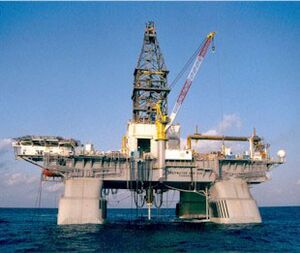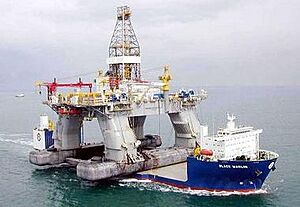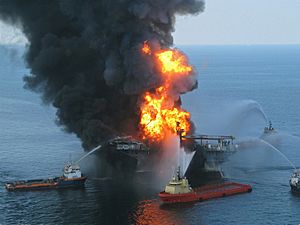Deepwater Horizon facts for kids

Deepwater Horizon semi-submersible drilling rig.
|
|
Quick facts for kids History |
|
|---|---|
| Name | Deepwater Horizon |
| Owner | Transocean's Triton Asset Leasing |
| Operator | Transocean |
| Port of registry | |
| Route | Gulf of Mexico |
| Ordered | December 1998 |
| Builder | Hyundai Heavy Industries |
| Cost | US$560 million |
| Way number | 89 |
| Laid down | 21 March 2000 |
| Completed | 2001 |
| Acquired | 23 February 2001 |
| Maiden voyage | Long Beach, California – Freeport, Texas |
| Out of service | 20 April 2010 |
| Identification |
|
| Fate | Sank on 22 April 2010 after an explosion and fire |
| Notes | Located in the Gulf of Mexico at a depth of 5,000 ft (1,500 m) at 28°44′12″N 88°23′13″W / 28.736667°N 88.386944°W |
| General characteristics | |
| Class and type | ABS +A1 DPS-3 Column Stabilized MODU |
| Displacement | 52.587 Mg |
| Length | 112 m |
| Beam | 78 m |
| Height | 97.5 m |
| Draught | 23 m (75 ft) |
| Depth | 41.5 m (136 ft) |
| Deck clearance | 34.010 m (111.58 ft) |
| Installed power |
|
| Propulsion | 8 × Kamewa 5.5 MW, 6.3 rad fixed-propeller azimuth thrusters |
| Speed | 2 m/s |
| Capacity |
|
| Crew | 150 |
The Deepwater Horizon was a huge offshore drilling rig. It was designed to drill for oil deep under the ocean. This rig was owned by a company called Transocean and operated by BP.
On April 20, 2010, while drilling in the Gulf of Mexico, a sudden release of gas caused a big explosion. This accident sadly killed 11 workers. The explosion also started a huge fire that could be seen from far away. Two days later, on April 22, the Deepwater Horizon sank. This left the oil well gushing oil into the sea. It became the largest oil spill in ocean history.
The rig was built in 2001 in South Korea. It was leased to BP from 2001 until 2013. In 2009, the Deepwater Horizon drilled the deepest oil well ever. It went over 35,050 ft (10,683 m) deep. This was in the Tiber Oil Field, about 250 miles (400 km) southeast of Houston.
Contents
What Was the Deepwater Horizon?
The Deepwater Horizon was a special type of drilling rig. It was called a "fifth-generation" rig. This means it used advanced technology. It was designed to drill deep under the sea. The rig could operate in waters as deep as 8,000 feet (2,400 m). It could drill down to 30,000 ft (9,100 m) below the seabed.
In 2010, there were only about 200 deepwater rigs like it. The Deepwater Horizon was one of the most powerful rigs in the world. In 2002, it got an upgrade called "e-drill." This system sent drilling information to experts in Houston, Texas. They could then help solve problems from far away.
The rig used many advanced systems. These included tools to check pressure and to control drilling. It also had systems for shutting off equipment automatically. These systems were very important for the rig's operations.
How Was the Rig Built and Used?
Building and Owning the Rig
The Deepwater Horizon was built in Ulsan, South Korea. Construction began in December 1998. It was finished and delivered on February 23, 2001. The rig was built for R&B Falcon, which later became part of Transocean.
Transocean operated the rig. It was leased to BP for use in the Gulf of Mexico. The lease was renewed several times. The last contract was for 2010 to 2013. This contract was worth about $544 million.
Where Did It Drill for Oil?
The Deepwater Horizon worked in several oil fields. These included the Atlantis Oil Field and Thunder Horse Oil Field. People sometimes called it a "lucky" rig. In 2006, it found oil in the Kaskida oil field. In 2009, it discovered the "giant" Tiber oil field.
The well in the Tiber field was the deepest oil well in the world. It went over 35,050 ft (10,683 m) below the seabed. This was much deeper than the rig's usual drilling limit.
In February 2010, the Deepwater Horizon started drilling a new well. This was at the Macondo Prospect. It was about 41 miles (66 km) off the coast of Louisiana. The water there was about 5,000 feet (1,500 m) deep. BP owned most of the rights to this area. The rig was still working at this site when the explosion happened on April 20, 2010.
The rig was usually very busy. It was working about 93% of the time it was in service. The rest of the time was spent moving between different drilling locations.
How Was Safety Checked?
The Minerals Management Service (MMS) was the group that checked offshore oil drilling in the United States of America. An investigation found that some safety papers were missing. These papers included information about what to do in an emergency like the one that happened.
The MMS was supposed to do monthly inspections. For the first few years, most inspections were done. But later, about 25% of the inspections were missed. This could happen if the weather was bad or the rig was moving. The last three inspections in 2010 each took two hours or less.
During its time in service, the rig received five warnings for not following rules. Four of these were in 2002 for safety issues. One was in 2003 for pollution. Overall, the Deepwater Horizon had a "strong" safety record. In 2009, the MMS even called it a "model for safety" in the industry.
The Explosion and Oil Spill
At 7:45 p.m. on April 20, 2010, something went wrong. A gush of seawater shot up from the rig. It went 70 metres (230 ft) into the air. Then, a mix of drilling mud, gas, and water erupted. The gas quickly caught fire. This caused a series of explosions and a huge fire.
Workers tried to activate the blowout preventer. This device is supposed to stop oil and gas from escaping. But it did not work. Another safety device, called a blind shear ram, was also activated. It was meant to seal the well. But it also failed.
Ten workers were believed to have died in the first explosion. An eleventh worker died in the fire that followed. The rig was quickly evacuated. Injured workers were flown to hospitals. After about 36 hours, the Deepwater Horizon sank on April 22, 2010. The rig's remains were found on the seafloor. They were about 1,500 metres (4,900 ft) deep.
The oil spill continued until July 15, 2010. That's when a cap was finally placed on the well. Later, special relief wells were drilled. These permanently sealed the well. The well was declared "effectively dead" on September 19, 2010. A project was started to help restore the coastline affected by the spill.
What Happened After the Spill?
After the accident, Transocean received money from its insurance. This was for the total loss of the Deepwater Horizon. The amount was about $401 million.
The legal process after the spill was very complex. Many lawsuits were filed. Experts said it was unlike anything seen before. It was expected to take many years to resolve.
In 2013, Transocean agreed to pay $1.4 billion. This was for breaking environmental laws. BP had also agreed to pay a large amount. In 2014, another company, Halliburton, agreed to pay $1.1 billion.
In September 2014, a judge ruled that BP was mostly responsible. The judge said BP's actions were "reckless." Transocean and Halliburton were also found to be "negligent." BP was given 67% of the blame. Transocean got 30%, and Halliburton 3%. BP disagreed with this ruling and planned to appeal.
In December 2014, the US Supreme Court rejected BP's challenge. BP had estimated it would pay about $7.8 billion to help victims. By 2018, about $65 billion had been paid in settlements. Thousands of claims were still being processed.
The Deepwater Horizon oil spill is often used as an example of a huge environmental disaster.
The Deepwater Horizon Movie
The movie Deepwater Horizon was released in 2016. It tells the story of the explosion and oil spill. The movie is based on an article from The New York Times.
See also
- Ixtoc I oil spill
- Ocean Ranger
- Piper Alpha
- Tony Hayward




